(Short answer:
Voltage on Non-Inverting input equals the Voltage on the Inverting Input. Using Ohms Law:
Voltage at the Inverting Input Equals the Current through the Feedback Resistor divided by Feedback resistance.
Voltage on the Non-Inverting Input is the Current Offset divided by the Non-Inverting Resistance and multiplied by the Non-Inverting Gain so...
IfRf = IcRc x (Rf +Ri)/Ri
Presuming Ic = If & solve for Rc and you will se Rc = Rf||Ri)
Long Answer:
I've been running through all the Equations put forth in Robert G. Irvine's 1981 Textbook "Operational Amplifiers: Characteristic & Applications"** and Chapter 3 is on "Offsets & Offset Compensation". Here is a paragraph word for word on the subject:
"Bias Currents flow into each Base of the (Op Amp Input Circuitry's) Differential Amplifier. These two currents are of the same order of magnitude and are nearly equal, but almost never exactly equal. The Difference B/T the two Bias Currents is the Offset Current. The OFFSET CURRENT is:
Equation 3-6
I(OI=Offset Current) = I(+) - I(-) (Bias Current on Non-Inv. less Bias on Inv.)
...and is usually less than 10% of the Average of the two Bias Currents. Thus, the Output Change Voltage could be reduced to 10% of it's value, due to Bias Currents, if the Change Voltage were related to Offset Current. This can be accomplished by placing a Current Compensating Resistor between the Non-Inverting Input and Ground (Rc). The bias current flowing through this resistor to the Non-Inverting input would then produce a negative voltage on the Non-Inverting input and would be amplified by the Non-Inverting Gain. This would partially offset the Bias Current on the Inverting Input. But what value of Rc to use?
A voltage appearing on the Non-Inverting Input will be multiplied by the Non-Inverting Gain as it appears on the Op Amp's Output. This voltage must equal the Change Voltage already on the Output due to the Inverting Input Bias Current. It is Opposite because of the Non-Inverting Gain.
Thus:
Equation 3-7
(I(-) x Rf) = (I(+) x Rc) x ((Rf + Ri)/Ri)
Where I(-) & I(+) will be presumed to be equal. Solving for Rc we get:
Rc = (Rf x Ri)/(Rf + Ri)
And it can be seen that Rc has a Resistance equal to the Parallel Resistance B/T Rf & Ri."
For your help the first 5 equations in this chapter are:
Eq. 3-1 "Output Voltage as sum of Expected Voltage and Change Voltage in an Inverting Amplifier Op-Amp":
Vo = (-Rf/Ri) x V(-) +/1 (Rf/Ri +1) x Vio
Eq. 3-2 "Relates Output Voltage Change to Input Offset Voltage":
Vov = (Rf/Ri +1) x Vio
Eq. 3-3 "Output Voltage as sum of Expected Voltage and Change Voltage in an Non-Inverting Amplifier Op-Amp":
Vo = (Rf/Ri+1) x V(+) +/1 (Rf/Ri + 1) x Vio
Eq. 3-4 "Since Input Offset Voltage of both Inverting & non=Inverting Amplifiers is multiplied by the Non-Inverting Gain the change, alone, in Output Voltage due to Input Offset Voltage is":
Vov = +/-(Rf/Ri + 1) x Vio
Eq. 3-5 "Input Offset Voltage of Inverting Input is equal to the Input Bias Current times the Feedback Resistance":
Voi = +(I(-) x Rf)
**Irvine, Robert G., "Operational Amplifiers: Characteristics & Applications", (1981), Prentice-Hall, Inc., Englewood, NJ 07632
